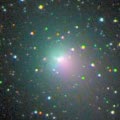
|
Now it is so bright as 8.3 mag (July 25, Juan Jose Gonzalez). It will be observable at 8-10 mag in good condition for a long time until late autumn.
Date(TT) R.A. (2000) Decl. Delta r Elong. m1 Best Time(A, h)
July 25 21 13.77 30 34.8 2.403 3.131 127 8.1 1:04 (180, 24)
Aug. 1 20 56.46 28 16.9 2.349 3.136 133 8.0 0:20 (180, 27)
|
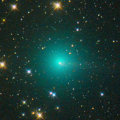
|
It brightened up to 6.7 mag in June (June 9, Marco Goiato). Now it is fading, but still bright as 9.4 mag (July 24, Juan Jose Gonzalez). In the Northern Hemisphere, it is observable until mid August in the evening low sky. In the Southern Hemisphere, it will be getting lower after this, and will be too low to observe in late August.
Date(TT) R.A. (2000) Decl. Delta r Elong. m1 Best Time(A, h)
July 25 12 35.29 -4 27.9 1.970 1.844 67 8.7 18:41 (126, 46)
Aug. 1 12 36.58 -2 16.5 2.142 1.866 60 9.1 18:45 (120, 39)
|
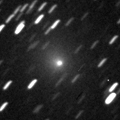
|
It brightened up to 8.5 mag in May and June (May 26, Juan Jose Gonzalez). Now it is fading, but still bright as 9.4 mag (July 19, Marco Goiato). It will never be observable again in the Northern Hemisphere. In the Southern Hemisphere, it keeps observable for a long time after this in the evening sky.
Date(TT) R.A. (2000) Decl. Delta r Elong. m1 Best Time(A, h)
July 25 9 27.95 -24 30.2 1.830 1.366 47 9.1 18:41 ( 74, 21)
Aug. 1 9 49.08 -28 52.7 1.851 1.419 49 9.3 18:45 ( 68, 21)
|
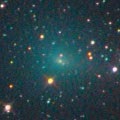
|
It brightened up to 8.8 mag in May and June (May 19, Juan Jose Gonzalez). Large diffuse object. However, it seems to be fading recently. Now it is 10.4 mag (July 25, Juan Jose Gonzalez). It will be bright at 9-10 mag for a long time until autumn.
Date(TT) R.A. (2000) Decl. Delta r Elong. m1 Best Time(A, h)
July 25 22 59.44 -9 58.8 0.782 1.690 139 9.6 2:49 (180, 65)
Aug. 1 23 0.09 -10 41.2 0.775 1.715 146 9.7 2:22 (180, 66)
|
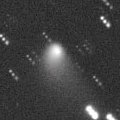
|
It brightened up to 9.8 mag on June 13 (Marco Goiato). Now it is not observable. But it keeps as bright as 10-11 mag for a long time untio 2010 spring. In the Northern Hemisphere, it will appear in the morning sky in early October, then it keeps observable at 10 mag in good condition for a long time. In the Southern Hemisphere, it will locate extremely low only after this.
Date(TT) R.A. (2000) Decl. Delta r Elong. m1 Best Time(A, h)
July 25 8 40.74 0 11.3 3.332 2.406 20 10.0 18:41 ( 88, -3)
Aug. 1 8 53.67 1 4.9 3.330 2.379 17 9.9 18:45 ( 86, -7)
|

|
It was bright as 8-9 mag in April and May. Now it is not observable. But it will appear in the morning sky again at 12 mag in late August, then it will be fading slowly in the low sky. In the Southern Hemisphere, it keeps observable in good condition for a long time after August.
Date(TT) R.A. (2000) Decl. Delta r Elong. m1 Best Time(A, h)
July 25 7 13.86 15 7.7 2.678 1.723 15 11.0 5:32 (254, -3)
Aug. 1 7 22.45 12 17.4 2.704 1.790 20 11.2 5:27 (254, 2)
|

|
It reaches up to 11 mag in summer. However, the condition of this apparition is worst. We can not observe it at all.
Date(TT) R.A. (2000) Decl. Delta r Elong. m1 Best Time(A, h)
July 25 8 21.94 23 56.4 2.241 1.231 4 11.8 18:41 (106,-19)
Aug. 1 8 50.45 22 45.1 2.227 1.219 4 11.6 18:45 (105,-19)
|
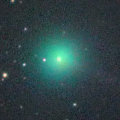
|
It has been observed bright as 8-9 mag from April to June. Now it is fading, but still bright as 11.0 mag (July 12, Marco Goiato). In the Southern Hemisphere, it keeps observable in a good condition for a long time. In the Northern Hemisphere, it will never be observable again.
Date(TT) R.A. (2000) Decl. Delta r Elong. m1 Best Time(A, h)
July 25 8 54.84 -53 57.3 1.899 1.892 74 11.7 18:41 ( 42, 28)
Aug. 1 9 14.10 -52 41.5 2.051 1.971 71 12.0 18:45 ( 42, 26)
|
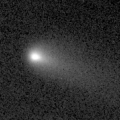
|
It has already brightened up to 11.3 mag (July 25, Juan Jose Gonzalez). It will be observable at 10-11 mag in a good condition for a long time from summer to winter.
Date(TT) R.A. (2000) Decl. Delta r Elong. m1 Best Time(A, h)
July 25 1 23.90 -3 11.5 0.691 1.357 103 12.4 5:12 (180, 58)
Aug. 1 1 54.71 -2 58.6 0.651 1.322 102 12.0 5:16 (180, 58)
|
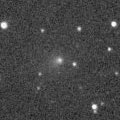
|
It is already bright as 12.7 mag and visible visually (July 19, Marco Goiato). It will be brightening rapidly after this, and will be 10 mag in autumn. It keeps observable for a long time until 2010 February. But in the Northern Hemisphere, it will be lower than 20 degree after August, then it keeps very low all through the brightest time. It locates a bit higher in the Southern Hemisphere.
Date(TT) R.A. (2000) Decl. Delta r Elong. m1 Best Time(A, h)
July 25 13 13.01 -7 50.2 1.482 1.609 77 12.8 18:41 (134, 55)
Aug. 1 13 25.91 -9 27.7 1.499 1.572 74 12.5 18:45 (126, 53)
|

|
Now it is very bright as 11.9 mag (July 12, Marco Goiato). However, it will be too low to observe soon. It will appear in the morning sky at 15 mag in early 2010. But it locates somewhat low in the Northern Hemisphere.
Date(TT) R.A. (2000) Decl. Delta r Elong. m1 Best Time(A, h)
July 25 11 41.81 2 12.5 2.632 2.175 52 13.0 18:41 (119, 32)
Aug. 1 11 54.58 0 40.9 2.691 2.177 49 13.1 18:45 (114, 30)
|

|
It passed near by the earth in late February, and it reached up to 4.9 mag (Feb. 23, Juan Jose Gonzalez). It has faded down to 11.8 mag (May 17, Carlos Labordena), and became unobservable. But it will appear in the morning sky again at 14 mag in August.
Date(TT) R.A. (2000) Decl. Delta r Elong. m1 Best Time(A, h)
July 25 7 11.02 21 23.7 3.929 2.963 15 13.7 5:32 (248, -6)
Aug. 1 7 13.59 21 17.3 3.959 3.039 21 13.8 5:27 (245, -2)
|
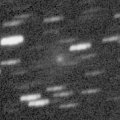
|
Appearing in the morning sky. Now it is 12.8 mag and visible visually (July 25, Juan Jose Gonzalez). It will be getting higher gradually while fading slowly after this.
Date(TT) R.A. (2000) Decl. Delta r Elong. m1 Best Time(A, h)
July 25 6 0.42 28 7.5 2.216 1.462 32 13.7 5:32 (233, 2)
Aug. 1 6 24.05 27 46.0 2.226 1.492 33 13.8 5:27 (233, 3)
|

|
It brightened up to 9.8 mag in winter (Dec. 28, Juan Jose Gonzalez). It faded down to 12.5 mag in May (May 26, Juan Jose Gonzalez), and became unobservable. Now it is not observable, however, it will be observable in good condition again in winter at 15 mag. Then it may be still visible visually.
Date(TT) R.A. (2000) Decl. Delta r Elong. m1 Best Time(A, h)
July 25 8 57.49 19 38.0 5.062 4.063 9 14.2 18:41 (107,-10)
Aug. 1 9 5.07 18 43.5 5.127 4.117 4 14.3 18:45 (103,-14)
|

|
It brightened up to 11.5 mag in last summer (Aug. 4, Marco Goiato). Although it is not observable in the Northern Hemisphere, it keeps observable in good condition for a long time in the Southern Hemisphere. However, no visual observations have been reported since last summer. Recent CCD observations suggest that it is still visible visually around 13-14 mag.
Date(TT) R.A. (2000) Decl. Delta r Elong. m1 Best Time(A, h)
July 25 6 15.79 -37 12.1 4.022 3.686 63 14.2 5:32 (294, 36)
Aug. 1 6 21.28 -37 6.5 4.053 3.734 64 14.3 5:27 (292, 39)
|

|
Now it is not observable. It will appear in the morning sky in September.
Date(TT) R.A. (2000) Decl. Delta r Elong. m1 Best Time(A, h)
July 25 8 43.85 18 35.7 7.156 6.148 6 14.2 18:41 (104,-12)
Aug. 1 8 49.17 18 11.0 7.164 6.150 1 14.2 18:45 (100,-17)
|
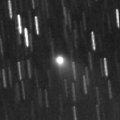
|
New bright periodic comet. It is still bright as 13.3 mag and visible visually (July 13, Carlos Labordena). Moving northwards in the Milky Way. In the Northern Hemisphere, the condition becomes good after this. But the comet will fade out rapidly. It will be fainter than 15 mag in August, and fainter than 18 mag in October.
Date(TT) R.A. (2000) Decl. Delta r Elong. m1 Best Time(A, h)
July 25 18 31.94 3 43.1 0.546 1.497 145 14.4 22:19 (180, 51)
Aug. 1 18 36.34 4 13.4 0.608 1.537 141 14.8 21:56 (180, 51)
|
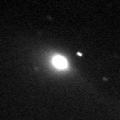
|
It brightened very rapidly, faster than expected, and reached up to 9.3 mag in spring (Mar. 26, Juan Jose Gonzalez). However, it will never be observable again in this apparition.
Date(TT) R.A. (2000) Decl. Delta r Elong. m1 Best Time(A, h)
July 25 9 49.69 18 10.8 2.972 2.064 21 14.5 18:41 (113, 1)
Aug. 1 10 4.74 16 48.8 3.051 2.118 19 14.8 18:45 (109, -2)
|

|
Now it is 12.5 mag and visible visually (July 24, Juan Jose Gonzalez). It will be getting lower in the evening sky, and will be too low to observe in August. It will brighten up to 12-13 mag in 2010 summer.
Date(TT) R.A. (2000) Decl. Delta r Elong. m1 Best Time(A, h)
July 25 12 33.21 3 24.4 3.058 2.774 64 14.5 18:41 (132, 40)
Aug. 1 12 41.11 2 10.0 3.119 2.756 60 14.6 18:45 (125, 37)
|
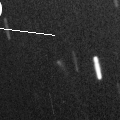
|
Now it is 15.2 mag (June 11, Artyom Novichonok). It keeps observable in good condition at 15 mag until late autumn.
Date(TT) R.A. (2000) Decl. Delta r Elong. m1 Best Time(A, h)
July 25 0 46.87 18 16.2 3.527 3.896 103 15.1 4:36 (180, 37)
Aug. 1 0 44.36 19 49.0 3.430 3.897 110 15.1 4:06 (180, 35)
|
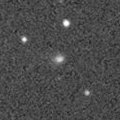
|
It has brightened up to 14 mag in outburst in 2008 August. Now it is bright as 14.3 mag (July 13, H. Sato), brighter than originally expected.
Date(TT) R.A. (2000) Decl. Delta r Elong. m1 Best Time(A, h)
July 25 21 18.80 -38 25.1 2.070 3.031 157 15.1 1:09 ( 0, 87)
Aug. 1 21 14.74 -39 31.9 2.081 3.044 157 15.2 0:38 ( 0, 86)
|
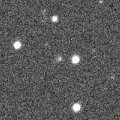
|
Now it is 15.9 mag (July 19, Ken-ichi Kadota). It will brighten up to 15 mag in 2009 and 2010, and will be observable for a long time in good condition.
Date(TT) R.A. (2000) Decl. Delta r Elong. m1 Best Time(A, h)
July 25 17 25.01 57 55.1 2.591 2.858 94 15.1 21:09 (180, -3)
Aug. 1 16 56.06 55 46.7 2.621 2.842 91 15.1 20:13 (180, -1)
|

|
It reached to 10.9 mag in 2008 spring (May 11, Marco Goiato). It is fading slowly. Now it is 13.4 mag (June 1, Juan Jose Gonzalez), still visible visually. It keeps bright as 13-14 mag for a long time after this until summer.
Date(TT) R.A. (2000) Decl. Delta r Elong. m1 Best Time(A, h)
July 25 16 2.88 35 25.6 4.415 4.672 98 15.3 19:50 (180, 20)
Aug. 1 16 3.33 34 43.8 4.525 4.722 94 15.4 19:23 (180, 20)
|

|
It passes the perihelion in September, and brightens up to 15 mag from summer to autumn. It keeps observable in good condition in the Southern Hemisphere. It is not observable now in the Northern Hemisphere. But it will appear in the evening sky at the end of September, and then it will be getting higher while fading.
Date(TT) R.A. (2000) Decl. Delta r Elong. m1 Best Time(A, h)
July 25 11 58.76 -51 34.7 0.957 1.347 86 15.4 18:41 ( 48, 55)
Aug. 1 12 19.25 -52 43.7 0.930 1.310 84 15.3 18:45 ( 47, 53)
|
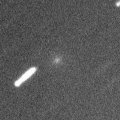
|
Now it is bright as 14.0 mag and visible visually (June 11, Juan Jose Gonzalez). However, it will be getting lower very rapidly in the evening sky, and will be too low to observe in early August. It was discovered in May, but it must have been bright and observable in the northern sky since winter.
Date(TT) R.A. (2000) Decl. Delta r Elong. m1 Best Time(A, h)
July 25 11 11.42 17 17.4 2.241 1.622 41 15.4 18:41 (125, 16)
Aug. 1 11 28.67 13 32.7 2.302 1.652 39 15.5 18:45 (120, 16)
|

|
Now it is 13.4 mag and visible visually (July 18, Jose Carvajal). It had been bright and visible visually around 13 mag from spring to autumn in 2008. It will be visible visually at 14 mag again until summer.
Date(TT) R.A. (2000) Decl. Delta r Elong. m1 Best Time(A, h)
July 25 13 4.69 34 26.1 7.234 6.856 64 15.5 18:41 (157, 16)
Aug. 1 13 4.02 33 53.8 7.344 6.884 59 15.6 18:45 (150, 14)
|

|
Now it is 16.5 mag (July 15, Ken-ichi Kadota), brightening as expected. It will reach up to 12 mag in 2012, and will be observable visually at 12-13 mag for a long time from 2011 to 2013. In 2009, it is observable in good condition at 16 mag from summer to autumn. In the Northern Hemisphere, the comet will be low around its brightest seasons.
Date(TT) R.A. (2000) Decl. Delta r Elong. m1 Best Time(A, h)
July 25 22 39.89 5 49.6 8.017 8.783 136 16.0 2:30 (180, 49)
Aug. 1 22 36.02 5 36.7 7.907 8.746 143 15.9 1:58 (180, 49)
|
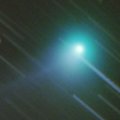
|
It reached to 6.3 mag in 2008 September in the southern sky (Sept. 4, Marco Goiato). Now it is fading. It has already faded down to 16.9 mag (June 11, Ken-ichi Kadota). It keeps observable in the northern sky while fading gradually. In the Southern Hemisphere, it will never be observable again.
Date(TT) R.A. (2000) Decl. Delta r Elong. m1 Best Time(A, h)
July 25 7 46.62 84 15.3 4.443 4.111 64 16.4 5:32 (187,-35)
Aug. 1 8 35.28 83 57.0 4.494 4.183 65 16.6 5:27 (187,-36)
|
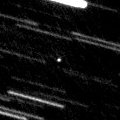
|
It passed the perihelion in June, but it was not observable, too close to the sun. Although it was predicted to be 13.5 mag, the STEREO spacecraft revealed that it brightened up to 10-11 mag, much brighter than expected. Now it is 15.8 mag (July 17, Michael Jager). It keeps observable at 16-17 mag until late autumn.
Date(TT) R.A. (2000) Decl. Delta r Elong. m1 Best Time(A, h)
July 25 4 37.82 39 33.5 1.139 0.931 50 16.5 5:32 (212, 5)
Aug. 1 4 38.49 41 0.4 1.166 1.049 56 16.7 5:27 (208, 6)
|
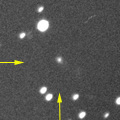
|
Now it is 16.4 mag (June 12, Ken-ichi Kadota). It will reach to 15 mag in 2010. It keeps observable for a long time after this in the Northern Hemisphere.
Date(TT) R.A. (2000) Decl. Delta r Elong. m1 Best Time(A, h)
July 25 15 3.51 8 7.6 5.431 5.663 97 16.7 18:51 (180, 47)
Aug. 1 15 4.13 8 10.3 5.502 5.630 92 16.7 18:45 (172, 47)
|

|
Appearing in the morning sky. It will brighten rapidly after this. It will reach to 12 mag and become visible visually in winter. In the Northern Hemisphere, it keeps observable in good condition for a long time after this until 2010 spring when it fades out.
Date(TT) R.A. (2000) Decl. Delta r Elong. m1 Best Time(A, h)
July 25 3 43.65 12 45.8 2.568 2.340 65 16.9 5:32 (217, 34)
Aug. 1 3 56.28 13 6.3 2.470 2.314 69 16.7 5:27 (214, 35)
|

|
Appearing in the morning sky. It has not been recovered yet. But it must have already brightened up to 17 mag. It will be getting higher rapidly after this, and will be observable in good condition at 16 mag in autumn.
Date(TT) R.A. (2000) Decl. Delta r Elong. m1 Best Time(A, h)
July 25 4 55.39 21 24.1 2.490 1.946 47 16.9 5:32 (227, 17)
Aug. 1 5 8.84 23 24.6 2.440 1.958 50 16.8 5:27 (224, 17)
|
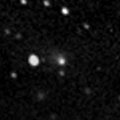
|
It brightened up to 15-16 mag in 2008 summer. Now appearing in the morning sky again. It keeps observable at 17 mag in good condition for a long time from summer to winter.
Date(TT) R.A. (2000) Decl. Delta r Elong. m1 Best Time(A, h)
July 25 3 14.63 25 47.3 3.177 2.970 69 17.0 5:32 (203, 25)
Aug. 1 3 22.41 26 44.7 3.102 2.984 73 17.0 5:27 (199, 26)
|
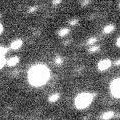
|
Now it is 17.4 mag (June 16, P. Kocher). It will be observable at 17 mag in 2009 summer and 2010 summer.
Date(TT) R.A. (2000) Decl. Delta r Elong. m1 Best Time(A, h)
July 25 17 23.00 -11 34.4 1.927 2.761 137 17.2 21:10 (180, 67)
Aug. 1 17 21.26 -11 33.8 1.969 2.740 130 17.2 20:40 (180, 67)
|
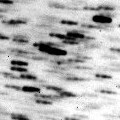
|
Now it is 17.0 mag (June 26, Charles Bell). The condition is good in this apparition. It will approach to the earth down to 0.38 A.U., and will be observable in good condition at 16.5 mag in November. It keeps observable until that time after this. But it locates somewhat low in the Northern Hemisphere.
Date(TT) R.A. (2000) Decl. Delta r Elong. m1 Best Time(A, h)
July 25 16 4.08 -19 56.5 0.702 1.502 120 17.6 19:51 (180, 75)
Aug. 1 16 1.84 -19 27.4 0.698 1.443 113 17.6 19:21 (180, 74)
|
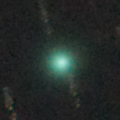
|
It brightened rapidly, and it reached up to 7.5 mag on Apr. 5 (Juan Jose Gonzalez). It is fading now. Extremely diffuse, and it is still very bright as 10.8 mag visually (June 21, Juan Jose Gonzalez). It may be visible visually still now with an excellent sky condition.
Date(TT) R.A. (2000) Decl. Delta r Elong. m1 Best Time(A, h)
July 25 19 10.67 1 58.9 1.087 2.044 152 17.6 22:55 (180, 53)
Aug. 1 18 46.22 -2 50.4 1.217 2.142 147 18.3 22:04 (180, 58)
|
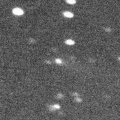
|
It was observed at 17.5 mag in 2008 summer. It is also observable at 17.5 mag in 2009 autumn. In the Northern Hemisphere, it located somewhat low in 2008, but it becomes observable in good condition in 2009.
Date(TT) R.A. (2000) Decl. Delta r Elong. m1 Best Time(A, h)
July 25 1 9.50 14 42.4 3.502 3.818 100 17.7 4:59 (180, 40)
Aug. 1 1 11.16 15 14.0 3.407 3.820 106 17.7 4:33 (180, 40)
|
|
![]()
 C/2009 G1 ( STEREO )
C/2009 G1 ( STEREO ) 217P/2009 F3 ( LINEAR )
217P/2009 F3 ( LINEAR ) 88P/Howell
88P/Howell 116P/Wild 4
116P/Wild 4 C/2007 N3 ( Lulin )
C/2007 N3 ( Lulin ) 64P/Swift-Gehrels
64P/Swift-Gehrels C/2006 OF2 ( Broughton )
C/2006 OF2 ( Broughton ) C/2007 G1 ( LINEAR )
C/2007 G1 ( LINEAR ) 29P/Schwassmann-Wachmann 1
29P/Schwassmann-Wachmann 1 P/2009 L2 ( Yang-Gao )
P/2009 L2 ( Yang-Gao ) 67P/Churyumov-Gerasimenko
67P/Churyumov-Gerasimenko 65P/Gunn
65P/Gunn C/2008 P1 ( Garradd )
C/2008 P1 ( Garradd ) 199P/2008 G2 ( Shoemaker 4 )
199P/2008 G2 ( Shoemaker 4 ) C/2008 N1 ( Holmes )
C/2008 N1 ( Holmes ) C/2006 Q1 ( McNaught )
C/2006 Q1 ( McNaught ) (3552) Don Quixote
(3552) Don Quixote C/2009 K4 ( Gibbs )
C/2009 K4 ( Gibbs ) C/2005 L3 ( McNaught )
C/2005 L3 ( McNaught ) C/2006 S3 ( LONEOS )
C/2006 S3 ( LONEOS ) C/2008 A1 ( McNaught )
C/2008 A1 ( McNaught ) (3200) Phaethon
(3200) Phaethon C/2008 FK75 ( Lemmon-Siding Spring )
C/2008 FK75 ( Lemmon-Siding Spring ) 118P/Shoemaker-Levy 4
118P/Shoemaker-Levy 4 P/2003 A1 ( LINEAR )
P/2003 A1 ( LINEAR ) 47P/Ashbrook-Jackson
47P/Ashbrook-Jackson 219P/2009 H1 ( LINEAR )
219P/2009 H1 ( LINEAR ) 107P/(4015) Wilson-Harrington
107P/(4015) Wilson-Harrington C/2009 E1 ( Itagaki )
C/2009 E1 ( Itagaki ) P/2008 O2 ( McNaught )
P/2008 O2 ( McNaught )![]()
































